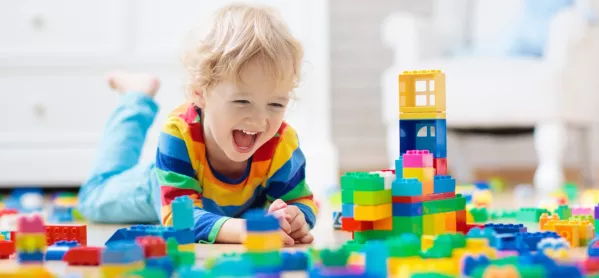EYFS: How to make tidying up effective and educational

It is 2.30pm and the bell signals that it’s tidy-up time. Glancing around the room, which resembles a bomb site, I see that the children have enjoyed exploring.
There is a sea of scrap paper, drippy glue splattered everywhere, and the carpet is covered in hundreds of pieces of Numicon. It feels like every single resource has been pulled out, used and dragged around the room.
Home time is approaching and an almighty clean-up needs to begin quickly. I look at the children, who haven’t grasped my urgency; Charlie is randomly spinning; Archie is sobbing over his broken model; and Amelia has lost her shoe. Marvellous.
EYFS: Why is tidying-up time important?
Tidy-up time is always difficult. Many children start school with absolutely no concept of tidying up. Why? Probably they lack the skills needed and don’t have enough prior experience. So, just like any other aspect of learning that children find difficult, it is our job to teach them.
It is easy to underestimate all of the skills needed, but there really is a lot of learning involved that can be linked to the EYFS framework, particularly personal, social and emotional development skills. When we consider this perspective, we can see the value of tidy-up time.
Children can learn about:
- Following instructions and listening.
- Classifying, sorting and counting objects.
- Reading labels.
- Working as a team.
- Understanding language and vocabulary.
- Carrying out tasks of responsibility.
The challenges
Frustratingly, it is often the same children doing all the work while others continue playing. Some have a wonderful knack of skipping off, suddenly desperate for the toilet. Many children are completely unaware of what they need to do. They begin to tidy, but quickly lose focus, drawn by the more exciting option of running around.
How should we manage tidy-up time?
One of my colleagues is particularly good at teaching the children these skills. She likens herself to an army major at tidy-up time, barking instructions loudly as she moves the children at a fast pace: “Bricks! Box! GO! “ and “Quick! Pens! Basket!”
The children seem to respond well to this command-and-control-type approach and work like little army troops for her. Like army troops, they get to this point through lots of training. She teaches the children the skills and offers lots of support through the year, so that they progress to only needing a short verbal prompt and encouragement to go at a pace.
I don’t have all the answers, but I have learned some useful tips over the years. The first and most important principle is to set expectations from the beginning. Children must hear the non-negotiable message that we are all responsible for our classroom. As a team, we are consistent with the idea that adults support children’s skills to tidy up, they don’t do the job for them.
Top tidy-up time tips
- Gather the children together first (especially if outdoors, as distraction levels are higher). Talk about what needs to be done, tasking small groups of children with each job. This works really effectively to involve every child.
- Use bags and baskets to bring novelty. Offer the bags for children to collect things from the floor and then sort them or to be used to collect a particular type of toy.
- Introduce an “I don’t know” box. Children use the box if they don’t know where something belongs, and these objects can be sorted as an activity later.
- Give your “happy wanderers” tasks. We all have those few children wandering around aimlessly. Ask, “Who needs a job?” and redirect them.
- Don’t play music. Personally, I find it doesn’t help as it tends to whip the children up and raise the noise levels so they cannot hear the instructions.
- Tidying up a large space is overwhelming for children. Recognise that tasks need to be broken down into small steps. They need lots of modelling and clear verbal direction.
- Refer children to one another for support. Encourage teamwork: lifting heavier items as a group, carrying things together, negotiating tasks, showing one another how it is done.
- Introduce the role of inspector, who checks that all areas are tidy. I give them a clipboard and a list to tick off each space. Children really love this role.
- Finally, that lost piece of clothing (or, in our case, a shoe) can often be found in the role-play washing machine, so remember to check in there!
Helen Pinnington is early years foundation lead at St Thomas More’s Catholic Primary School in Bedhampton, Hampshire
You need a Tes subscription to read this article
Subscribe now to read this article and get other subscriber-only content:
- Unlimited access to all Tes magazine content
- Exclusive subscriber-only stories
- Award-winning email newsletters
Already a subscriber? Log in
You need a subscription to read this article
Subscribe now to read this article and get other subscriber-only content, including:
- Unlimited access to all Tes magazine content
- Exclusive subscriber-only stories
- Award-winning email newsletters